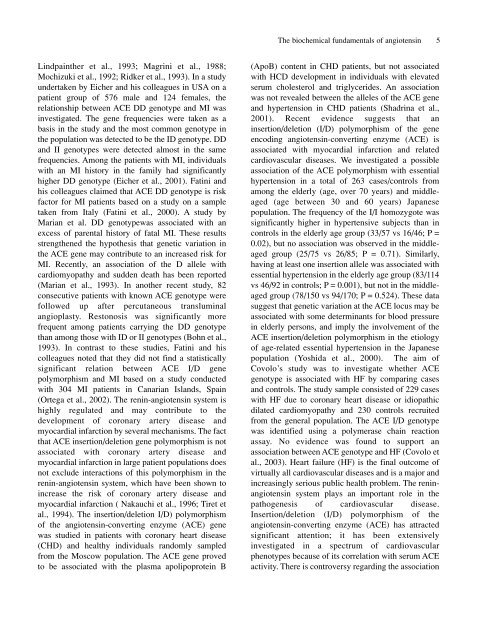Full Journal - Journal of Cell and Molecular Biology - Haliç Üniversitesi
Full Journal - Journal of Cell and Molecular Biology - Haliç Üniversitesi
Full Journal - Journal of Cell and Molecular Biology - Haliç Üniversitesi
Create successful ePaper yourself
Turn your PDF publications into a flip-book with our unique Google optimized e-Paper software.
Lindpainther et al., 1993; Magrini et al., 1988;<br />
Mochizuki et al., 1992; Ridker et al., 1993). In a study<br />
undertaken by Eicher <strong>and</strong> his colleagues in USA on a<br />
patient group <strong>of</strong> 576 male <strong>and</strong> 124 females, the<br />
relationship between ACE DD genotype <strong>and</strong> MI was<br />
investigated. The gene frequencies were taken as a<br />
basis in the study <strong>and</strong> the most common genotype in<br />
the population was detected to be the ID genotype. DD<br />
<strong>and</strong> II genotypes were detected almost in the same<br />
frequencies. Among the patients with MI, individuals<br />
with an MI history in the family had significantly<br />
higher DD genotype (Eicher et al., 2001). Fatini <strong>and</strong><br />
his colleagues claimed that ACE DD genotype is risk<br />
factor for MI patients based on a study on a sample<br />
taken from Italy (Fatini et al., 2000). A study by<br />
Marian et al. DD genotypewas associated with an<br />
excess <strong>of</strong> parental history <strong>of</strong> fatal MI. These results<br />
strengthened the hypothesis that genetic variation in<br />
the ACE gene may contribute to an increased risk for<br />
MI. Recently, an association <strong>of</strong> the D allele with<br />
cardiomyopathy <strong>and</strong> sudden death has been reported<br />
(Marian et al., 1993). In another recent study, 82<br />
consecutive patients with known ACE genotype were<br />
followed up after percutaneous transluminal<br />
angioplasty. Restonosis was significantly more<br />
frequent among patients carrying the DD genotype<br />
than among those with ID or II genotypes (Bohn et al.,<br />
1993). In contrast to these studies, Fatini <strong>and</strong> his<br />
colleagues noted that they did not find a statistically<br />
significant relation between ACE I/D gene<br />
polymorphism <strong>and</strong> MI based on a study conducted<br />
with 304 MI patients in Canarian Isl<strong>and</strong>s, Spain<br />
(Ortega et al., 2002). The renin-angiotensin system is<br />
highly regulated <strong>and</strong> may contribute to the<br />
development <strong>of</strong> coronary artery disease <strong>and</strong><br />
myocardial infarction by several mechanisms. The fact<br />
that ACE insertion/deletion gene polymorphism is not<br />
associated with coronary artery disease <strong>and</strong><br />
myocardial infarction in large patient populations does<br />
not exclude interactions <strong>of</strong> this polymorphism in the<br />
renin-angiotensin system, which have been shown to<br />
increase the risk <strong>of</strong> coronary artery disease <strong>and</strong><br />
myocardial infarction ( Nakauchi et al., 1996; Tiret et<br />
al., 1994). The insertion/deletion I/D) polymorphism<br />
<strong>of</strong> the angiotensin-converting enzyme (ACE) gene<br />
was studied in patients with coronary heart disease<br />
(CHD) <strong>and</strong> healthy individuals r<strong>and</strong>omly sampled<br />
from the Moscow population. The ACE gene proved<br />
to be associated with the plasma apolipoprotein B<br />
The biochemical fundamentals <strong>of</strong> angiotensin 5<br />
(ApoB) content in CHD patients, but not associated<br />
with HCD development in individuals with elevated<br />
serum cholesterol <strong>and</strong> triglycerides. An association<br />
was not revealed between the alleles <strong>of</strong> the ACE gene<br />
<strong>and</strong> hypertension in CHD patients (Shadrina et al.,<br />
2001). Recent evidence suggests that an<br />
insertion/deletion (I/D) polymorphism <strong>of</strong> the gene<br />
encoding angiotensin-converting enzyme (ACE) is<br />
associated with myocardial infarction <strong>and</strong> related<br />
cardiovascular diseases. We investigated a possible<br />
association <strong>of</strong> the ACE polymorphism with essential<br />
hypertension in a total <strong>of</strong> 263 cases/controls from<br />
among the elderly (age, over 70 years) <strong>and</strong> middleaged<br />
(age between 30 <strong>and</strong> 60 years) Japanese<br />
population. The frequency <strong>of</strong> the I/I homozygote was<br />
significantly higher in hypertensive subjects than in<br />
controls in the elderly age group (33/57 vs 16/46; P =<br />
0.02), but no association was observed in the middleaged<br />
group (25/75 vs 26/85; P = 0.71). Similarly,<br />
having at least one insertion allele was associated with<br />
essential hypertension in the elderly age group (83/114<br />
vs 46/92 in controls; P = 0.001), but not in the middleaged<br />
group (78/150 vs 94/170; P = 0.524). These data<br />
suggest that genetic variation at the ACE locus may be<br />
associated with some determinants for blood pressure<br />
in elderly persons, <strong>and</strong> imply the involvement <strong>of</strong> the<br />
ACE insertion/deletion polymorphism in the etiology<br />
<strong>of</strong> age-related essential hypertension in the Japanese<br />
population (Yoshida et al., 2000). The aim <strong>of</strong><br />
Covolo’s study was to investigate whether ACE<br />
genotype is associated with HF by comparing cases<br />
<strong>and</strong> controls. The study sample consisted <strong>of</strong> 229 cases<br />
with HF due to coronary heart disease or idiopathic<br />
dilated cardiomyopathy <strong>and</strong> 230 controls recruited<br />
from the general population. The ACE I/D genotype<br />
was identified using a polymerase chain reaction<br />
assay. No evidence was found to support an<br />
association between ACE genotype <strong>and</strong> HF (Covolo et<br />
al., 2003). Heart failure (HF) is the final outcome <strong>of</strong><br />
virtually all cardiovascular diseases <strong>and</strong> is a major <strong>and</strong><br />
increasingly serious public health problem. The reninangiotensin<br />
system plays an important role in the<br />
pathogenesis <strong>of</strong> cardiovascular disease.<br />
Insertion/deletion (I/D) polymorphism <strong>of</strong> the<br />
angiotensin-converting enzyme (ACE) has attracted<br />
significant attention; it has been extensively<br />
investigated in a spectrum <strong>of</strong> cardiovascular<br />
phenotypes because <strong>of</strong> its correlation with serum ACE<br />
activity. There is controversy regarding the association

















